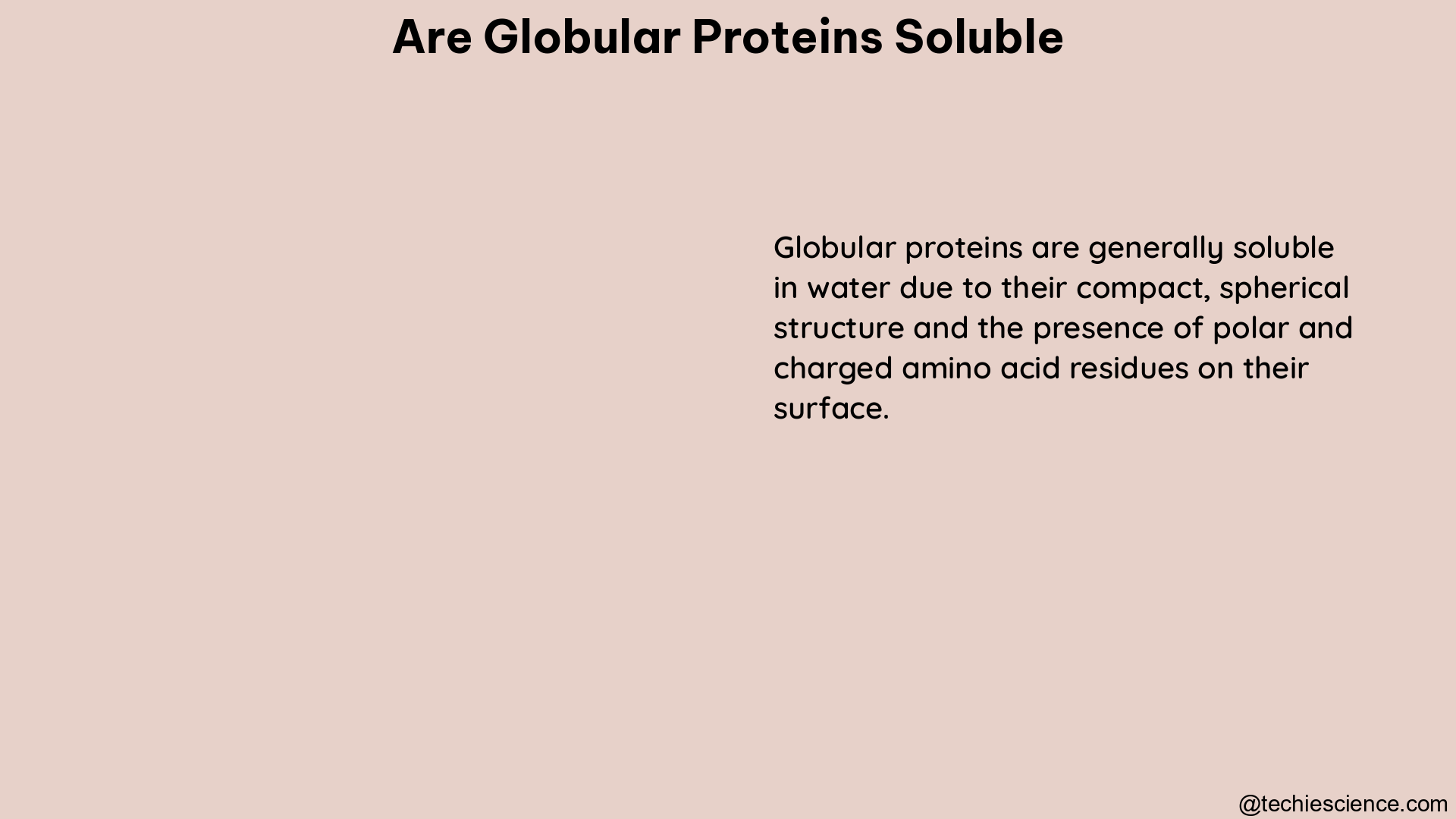Globular proteins are a class of proteins that are generally soluble in water and can be crystallized from solution, in contrast to fibrous proteins which are insoluble in water. The solubility of globular proteins is a crucial property that affects their functionality and applications in various fields, including biochemistry, biotechnology, and food science.
Understanding Globular Protein Solubility
The solubility of globular proteins is influenced by several factors, including their amino acid composition, molecular configuration, and physicochemical characteristics.
Amino Acid Composition and Sequence
The amino acid composition and sequence of globular proteins play a significant role in their solubility. Proteins with a higher proportion of polar and charged amino acids, such as lysine, arginine, aspartic acid, and glutamic acid, tend to be more soluble in water due to their ability to form hydrogen bonds and ionic interactions with water molecules. Conversely, proteins with a higher proportion of hydrophobic amino acids, such as alanine, valine, leucine, and isoleucine, are less soluble in water.
The specific arrangement of these amino acids within the protein structure can also impact solubility. For example, the presence of charged or polar amino acids on the protein surface can increase its solubility by enhancing its interaction with water molecules.
Molecular Configuration and Size
The three-dimensional structure of globular proteins, known as their tertiary structure, also plays a crucial role in their solubility. Globular proteins typically adopt a compact, spherical shape, which helps to minimize the exposure of hydrophobic regions to the aqueous environment. This compact structure, along with the presence of charged and polar groups on the protein surface, contributes to the overall solubility of globular proteins.
The size of the globular protein also affects its solubility. Smaller proteins generally have a higher surface-to-volume ratio, which can enhance their solubility compared to larger proteins. However, the relationship between protein size and solubility is not always linear, as other factors, such as the distribution of charged and polar groups, can also influence solubility.
Physicochemical Characteristics
The physicochemical characteristics of globular proteins, such as surface polarity, net charge, and the presence of reactive groups, can also impact their solubility.
-
Surface Polarity: Proteins with a higher proportion of polar and charged amino acids on their surface tend to be more soluble in water, as they can form favorable interactions with water molecules.
-
Net Charge: The overall net charge of a globular protein can affect its solubility. Proteins with a net positive or negative charge are generally more soluble in water due to their ability to form ionic interactions with the solvent.
-
Reactive Groups: The presence of reactive groups, such as sulfhydryl (-SH) or disulfide (-S-S-) groups, can also influence the solubility of globular proteins. These groups can participate in various chemical reactions, which can alter the protein’s solubility.
Examples of Soluble Globular Proteins

Globular proteins can be classified into different categories based on their solubility characteristics:
-
Globulins: These proteins are soluble in salt water (saline solutions) and include immunoglobulins, which are essential components of the immune system.
-
Albumins: These proteins are soluble in water and are the most abundant proteins in blood plasma, playing crucial roles in maintaining osmotic pressure and transporting various molecules.
-
Prolamins: These proteins are soluble in alcohol or alcohol-water mixtures and are found in cereal grains, such as wheat, corn, and barley.
-
Glutelins: These proteins are soluble in acidic or alkaline water and are also found in cereal grains.
Factors Affecting Globular Protein Solubility
The solubility of globular proteins can be influenced by various factors, including:
-
pH: The pH of the solution can affect the ionization state of the amino acid residues in the protein, which can impact its solubility. Proteins typically have optimal solubility near their isoelectric point (pI), where the net charge is zero.
-
Temperature: Changes in temperature can affect the solubility of globular proteins. Generally, increasing the temperature can enhance the solubility of proteins, as it can disrupt the hydrophobic interactions that contribute to protein aggregation.
-
Ionic Strength: The presence of salts in the solution can affect the solubility of globular proteins. Moderate concentrations of salts can enhance solubility by shielding the charged groups on the protein surface, while high salt concentrations can lead to protein precipitation or salting-out.
-
Dehydration: Removal of bulk water from globular proteins, such as during film formation or lyophilization (freeze-drying), can have varying effects on their solubility. Studies have shown that globular proteins exhibit only minor changes in solubility upon dehydration, in contrast to intrinsically disordered proteins (IDPs), which can undergo significant conformational changes.
-
Protein Concentration: The solubility of globular proteins can be influenced by their concentration in the solution. At higher concentrations, proteins may begin to aggregate and precipitate, reducing their solubility.
Implications of Globular Protein Solubility
The solubility of globular proteins has important implications in various fields:
-
Biochemistry and Biotechnology: The solubility of globular proteins is crucial for their purification, characterization, and use in various biochemical and biotechnological applications, such as enzyme-based processes, protein-based therapeutics, and biosensors.
-
Food Science: The solubility of globular proteins, such as those found in milk, eggs, and plant-based sources, affects their functionality in food products, including their ability to form emulsions, foams, and gels, which are important for texture and stability.
-
Pharmaceutical Applications: The solubility of globular proteins is a critical factor in the development of protein-based drugs and formulations, as it can impact their bioavailability, stability, and delivery.
-
Structural Biology: Understanding the factors that govern the solubility of globular proteins is essential for studying their three-dimensional structures and interactions, which is crucial for elucidating their biological functions and potential applications.
In conclusion, the solubility of globular proteins is a complex and multifaceted property that is influenced by various factors, including amino acid composition, molecular configuration, and physicochemical characteristics. This understanding of globular protein solubility has important implications in diverse fields, from biochemistry and biotechnology to food science and pharmaceutical development.
References:
- Residue level quantification of protein stability in living cells – PMC
- Structural hot spots for the solubility of globular proteins – PMC – NCBI
- Globular Protein – an overview | ScienceDirect Topics
- Differential dehydration effects on globular proteins and intrinsically disordered proteins during film formation
- Deep dive: Plant-based meat crop development | GFI

Hi, I am Milanckona Das and pursuing my M. Tech in Biotechnology from Heritage Institute of Technology. I have a unique passion for the research field. I am working in Lambdageeks as a subject matter expert in biotechnology.
LinkedIn profile link-